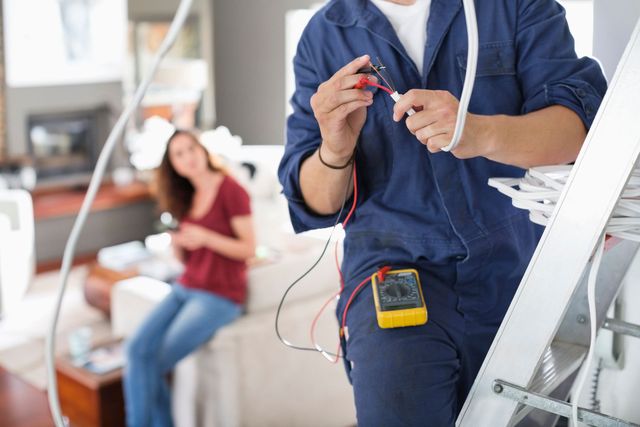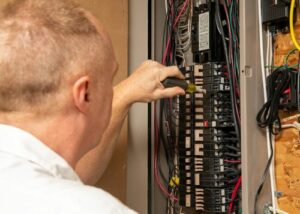Typical Electric Troubles Every House Owner Need To Learn about
Home owners often encounter numerous electrical problems that can influence security and capability. Problems like flickering lights and tripped circuit breakers are a lot more usual than numerous realize. These scenarios can suggest much deeper electrical issues that warrant focus. Recognizing the threats and signs connected with obsolete electrical wiring and dead outlets is vital. What actions can be taken to protect against these troubles? Exploring these usual electrical concerns might disclose crucial understandings for maintaining a risk-free home atmosphere.

Flickering Lights: Reasons and Solutions
Why do some homeowners experience flickering lights? Flickering lights can be a typical annoyance, commonly showing underlying electrical concerns. One primary cause is defective or loosened connections within light components or wiring, which can result in intermittent power supply. Additionally, utilizing high-wattage appliances on the exact same circuit may cause voltage changes, leading to lowering or flickering. An additional prospective problem is an overloaded circuit, where a lot of devices attract power at the same time, straining the electric system. Abject or obsolete circuitry can contribute to inconsistent electrical flow. In some cases, flickering lights may signify a problem with the home's electrical panel or solution line. Property owners need to address flickering lights without delay to avoid potential threats. Solutions might consist of tightening up links, redistributing device load, or getting in touch with a qualified electrical contractor for a thorough assessment. Identifying the root reason can help guarantee a risk-free and steady electrical system in the home.
Tripped Circuit Breakers: What You Required to Know
Have homeowners ever before questioned what causes their circuit breakers to trip all of a sudden? This typical concern often develops from an overload of electrical circuits, where a lot of tools draw power concurrently. In such cases, the circuit breaker functions as a security device, interrupting the flow of electricity to avoid getting too hot and prospective risks. An additional regular cause is a brief circuit, which happens when an online cable get in touches with a neutral cord, producing a surge of electricity that trips the breaker. Ground faults can additionally bring about tripped breakers; these take place when an online cord touches the ground or a based surface, presenting severe safety dangers. House owners should consistently assess their usage of high-wattage appliances to stay clear of overloading circuits. In addition, comprehending the feature of breaker can help them respond suitably throughout a journey, ensuring their home remains well-maintained and secure.
Obsolete Circuitry: Indicators and Risks
Outdated wiring can pose significant threats to home owners, often going unnoticed until troubles arise. Houses built before the 1980s might still have aluminum circuitry or knob-and-tube systems, which are no much longer considered risk-free. Indicators of obsolete wiring include flickering lights, frequently tripped breaker, or burning smells near electrical outlets. These indications may suggest that the electric system is overloaded or deteriorating.Additionally, home owners may observe scorch marks around electrical outlets or switches, which can suggest getting too hot. The danger of electric fires substantially boosts with out-of-date electrical wiring, as these systems were not made to take care of modern-day electric tons. Home owners are urged to have their circuitry inspected regularly, particularly when renovating or including brand-new home appliances. By recognizing these signs early, they can prevent unsafe circumstances and keep a safer living setting. Updating to present electric requirements is a proactive step in keeping home safety and performance.
Regularly Blown Fuses: Repairing Tips
Constant blown integrates can suggest underlying electrical issues that may stem from out-of-date circuitry or overloaded circuits. Property owners experiencing this problem needs to first determine the appliances linked to the affected circuit. It is recommended to prevent using numerous high-wattage tools at the same time, as this can lead to circuit overload. If the issue lingers, evaluating the fuse box for signs of wear or damages is crucial; a damaged circuit box may require replacement.Additionally, examining for loosened links within the circuit can help avoid future occurrences. Home owners must likewise verify that the merges being utilized are of the proper amperage, as utilizing an inaccurate fuse can worsen the issue. Seeking advice from a licensed electrical contractor is suggested to assess the electric system better if these troubleshooting ideas do not solve the concern. Addressing these worries without delay can help alleviate threats and guarantee the safety and security of the home's electrical facilities.
Dead Electrical Outlets: Common Causes and Fixes
When a property owner runs into a dead outlet, it can often provide aggravation and confusion. A number of usual reasons may bring about this issue. One regular wrongdoer is a stumbled breaker, which can be conveniently reset. If any type of breakers are in the off placement, home owners ought to inspect their electrical panel to examine. An additional opportunity is a malfunctioning outlet itself, which may call for replacement. Furthermore, loosened circuitry connections within the outlet can disrupt power circulation, making evaluation essential.Sometimes, the trouble may stem from an overloaded circuit, specifically when numerous tools are attached. In such instances, redistributing the electrical tons can resolve the concern. House owners should additionally consider the age of their electrical wiring; older systems might call for updates to fulfill contemporary electrical needs. If these actions do not fix the scenario, speaking navigate to these guys with a licensed electrical contractor is a good idea to guarantee safety and proper medical diagnosis.
Electric Shocks: When to Be Concerned
How can house owners determine whether an electrical shock warrants concern? Homeowners must first analyze the extent and context of the shock. A light fixed shock, often felt when touching metal items, is typical and normally harmless. Nevertheless, if the shock takes place while interacting with a plugged-in device or electrical outlet, it might suggest a much more severe issue.The place and regularity of the shocks are essential. Repetitive shocks from the very same source, specifically in damp locations like restrooms or kitchen areas, might indicate faulty electrical wiring or poor grounding. Home owners need to additionally consider the sensation of the shock; a jolt that creates discomfort or muscle contractions is more disconcerting than a simple tingle.If there's any kind of uncertainty, it is suggested to speak with a qualified electrical expert. Disregarding prospective electrical hazards can lead hop over to here to serious safety threats, consisting of fire or extreme injury.
Overloaded Circuits: Prevention and Precaution
Overloaded circuits present considerable dangers in property setups, frequently resulting in electrical fires or devices damage (Sydney Level 2 Electrician). House owners should recognize the indicators of an overloaded circuit, such as frequently stumbled breakers or lowering lights. Executing precautionary security practices can aid reduce these threats and ensure a safer living setting
Recognizing Overloaded Circuits
What signs suggest that a circuit may be overloaded? Property owners need to be watchful for numerous essential indications. Often stumbled circuit breakers or blown merges recommend excessive tons on the circuit. Dimming or flickering lights, especially when other devices are in use, can symbolize a poor power supply. Additionally, outlets or buttons that really feel warm to the touch may suggest overheating, a possible fire hazard. Uncommon humming audios from outlets likewise necessitate attention, as they can represent electric problems. If appliances run inefficiently or stop working to start, it may be an indication of an overloaded circuit. Identifying these signs early can assist stop severe electric issues and advertise a safer home atmosphere.
Preventive Security Practices
To preserve a reliable and secure electric system, homeowners need to apply preventative safety and security techniques that deal with possible circuit overloads. One efficient action is to stay clear of connecting as well lots of gadgets to a single outlet, as this can surpass the circuit's ability. Making use of power strips with built-in circuit breakers can aid distribute power safely. Homeowners should additionally routinely inspect cables and devices for damages and change any defective equipment quickly. It is essential to ensure that circuit breakers are functioning appropriately and to be conscious of the total power level being used in each circuit. Additionally, getting in touch with an accredited electrical expert for periodic assessments can identify prospective issues prior to they intensify, ensuring a more secure living environment and prolonging the lifespan of electric systems.
Frequently Asked Inquiries
Exactly how Commonly Should I Have My Electrical System Inspected?
Normal assessments of electrical systems are suggested every three to 5 years. Property owners should consider much more regular checks if go to this website they experience issues, embark on renovations, or reside in older buildings to guarantee safety and security and compliance.
Can I Repair Electric Problems Myself or Work With a Professional?

What Are the Indicators of an Electrical Fire Threat?
Indicators of an electric fire danger consist of frequently stumbled circuit breakers, flickering lights, melting smells, discolored electrical outlets, or warm, humming cables. Homeowners need to stay watchful and seek professional help if any one of these signs exist.
Exactly how Do I Know if My Home Demands an Electric Upgrade?
To establish if a home needs an electrical upgrade, indications include constant breaker journeys, obsolete circuitry, not enough electrical outlets, flickering lights, and the presence of older electrical panels, suggesting possible security risks and ineffectiveness.
Are There Particular Safety Tips for DIY Electric Job?
When considering do it yourself electric work, one ought to always shut off power, make use of shielded tools, confirm circuit performance, follow neighborhood codes, and consult specialists for complex jobs to assure safety and security and protect against crashes. An additional possible problem is an overloaded circuit, where as well lots of gadgets attract power simultaneously, stressing the electrical system. The threat of electrical fires considerably raises with out-of-date wiring, as these systems were not created to manage modern-day electric lots. Constant blown integrates can indicate underlying electric concerns that may stem from obsolete electrical wiring or overloaded circuits. To maintain a effective and safe electric system, house owners must implement preventative safety and security methods that address prospective circuit overloads. Sydney Level 2 Electrician. Signs of an electric fire danger consist of often tripped circuit breakers, flickering lights, burning smells, discolored electrical outlets, or cozy, buzzing cables
Comments on “Electrical safety checklist by a ASP Level 2 Electrician”